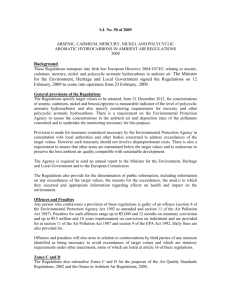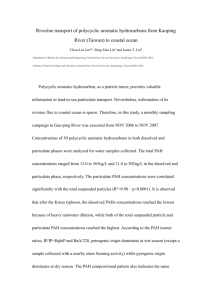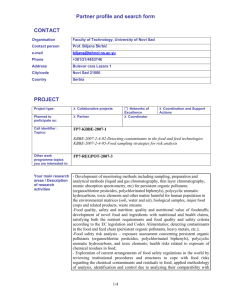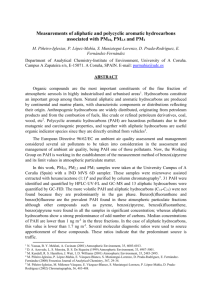The Health and Social Impacts of Polycyclic Aromatic Hydrocarbons
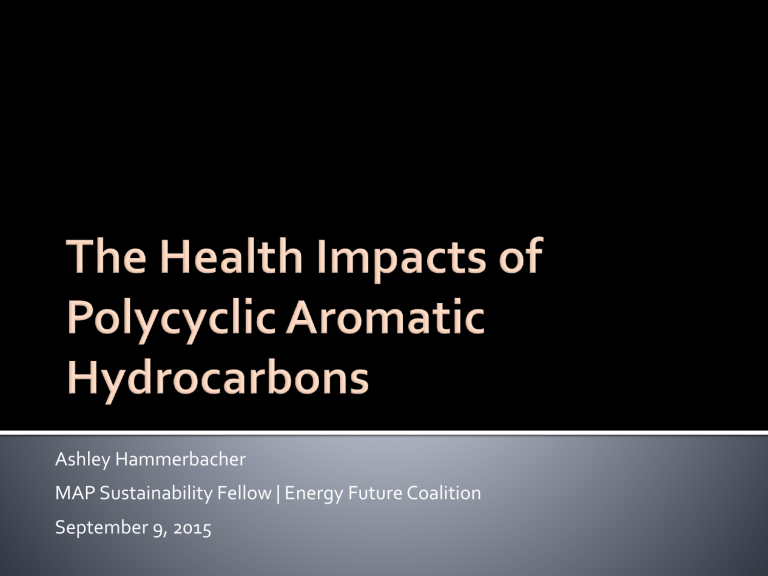
Ashley Hammerbacher
MAP Sustainability Fellow | Energy Future Coalition
September 9, 2015
7%
4%
3%
1%
9%
76%
Incomplete Combustion:
Residential and Commerical
Combustion
Incomplete Combustion:
Industrial Combustion
Road Transport
Metal Production
Waste Incineration
Other Sources
Citation
Important Conclusions
Measurement Techniques
Particle Type
Criticisms
Perera 2012Perera, Frederica P. et al.
“Prenatal Polycyclic
Aromatic Hydrocarbon characterized by personal air monitoring (greater than median of 2.27 ng/m^3) or maternal and cord adducts
(PAH) Exposure and Child
Behavior at Age 6-7 Years.” symptoms of anxious/depressed and attention problems
Environmental Health
(detectable or higher) was positively associated with
* Developmental: Experimental studies exposing
Perspectives (2012): n. pag. Web.
* Developmental: High prenatal PAH exposure, whether laboratory animals to PAH during the prenatal and neonatal periods have reported neurodevelopmental and behavioral
* Children of nonsmoking African-American and Dominican women in New York City were followed from in utero in 6-7 years.
* Prenatal PAH exposure was estimated by personal air monitoring of the mothers during pregnancy as well as by the measurements of effects including impairment of memory and ability to learn, * At 6-7 years of age, child behavior was anxiety, and depression-like symptoms in the absence of overt toxicologic
DNA adducts specific to BaP, a representative
PAH, in maternal and cord blood. assessed using the Child Behavior Checklist
* Generalized linear models were sued to test
* Devlopmental: In the full Poisson model after adjusting for possible confounders, highly monitored PAH exposure was associated with significantly higher symptom score of
Anxious/Depressed
* Developmental: There is an association between child behvioral problems and two complementary measures specific to prenatal PAH exposure (prenatally monitored air concentrations of PAH and a PAH-specific biomarker of exposure in cord blood
* Developmental: CONFIRMED THAT there is a significant the association between prenatal PAH exposure and behavioural outcomes
Perera 2014Perera, Frederica P et al.
“Early-Life Exposure to
Polycyclic Aromatic
Hydrocarbons and ADHD
Behavior Problems.” PloS one 9.11 (2014): e111670.
Web. 8 June 2015.
association between prenatal exposure to PAH and indicators of both Anxious/Depressed and Attention
Problems in children
*
* Developmental: The results suggest that exposure to PAH encountered in NYC air may play a role in childhood ADHD behavioral problems ("The present results suggest that high prenatal exposure, taking into account the potential effects of postnatal PAH exposure increase the risk of ADHD behavior problems.
* Source: In NYC and other urban areas, traffic and residential heating are major local sources. There is also some contribution from coal-burning sources in states upwind
* Social: Urban, minority populations in the US often have disproportionate exposure to air pollution and are at a greater risk for adverse health and developmental
* Children of nonsmoking African-American and Dominican women in New York City were followed from in utero in 9 years.
* Subjects were given questionnaire to obtain demographic info, residential Hx and health and environmental data such as smoking.
* Prenatal PAH expsoure was estimated by level sof PAH-DNA adducts in maternal and cord blood collected at delivery. Postnatal exposure was estimated by the concentration of urinary polycyclic aromatic hydrocarbon metabolites at ages 3 or 5
* Attention Deficit Hyperactivity Disorder outcomes from this exposure
* Developmental: Laboratory studies of pah exposure during the prenatal, neonatal or adult periods have reported a range of neurodevelopmental and behavioral effects including hyperactivity
* Developmental: In the Columbia Center for Children's
Environmental Health (CCCEH) NYC Cohort, prenatal exposure to PAH measured by prenatal air monitoring or
BaP DNA adducts in maternal or umbilical cord blood at delivery was associated with developmental delay at age 3, reduced IQ at age 5 and symptoms of anxiety/depression
Behavior problems were assessed using the
C hild Behavior Checklist (CBCL) and the
Conners Parent Rating Scale-Revised (CPRS)
The CBCL is a screening instrument assessing childhood competencies, adaptive functioning and problems
* The CPRS is a focused assessment of childhood ADHSD and its common comorbid disorders
* Used urinary PAH metabolites to assess postnatal exposure (the biomarker has been
PAH * Unmeasured factors such as s other pollutants and stress may have contributed to epideiologic study
* A signle 48hr prenatal monitoring during the second or third trimester was used as a basis for estimating exposure (but it has been associated with adverse health and developmental outcomes in two cohorts and has been correlated with indoor PAH concentrations monitored over a
6 wek period as well as with indoor and outdoor PAH concentrations monitored during the same 48 hr time period
PAH s
* Results were only conclusive using one of the two tests for
ADHD (the detailed CPRS had consistently significant associations with the number of cases that they have found) unlike the CBCL test where there was no statistically significant result
* Used urinary biomarkers which unfortunately give short term exposure ( although the metabolites can provide a chronic measure of ambient PAH in populations with constant exposure)
* Although they measured many of the confounding variables, the study was unable to take into account factors such as other pollutants, stress and noise that may have contributed to residual confounding.
Citation: Perera, Frederica P et al. “Early-Life
Exposure to Polycyclic Aromatic
Hydrocarbons and ADHD Behavior
Problems.” PloS one 9.11 (2014): e111670.
Web. 8 June 2015.
•
•
•
•
•
•
•
Developmental: The results suggest that exposure to PAH encountered in NYC air may play a role in childhood
ADHD behavioral problems ("The present results suggest that high prenatal exposure, taking into account the potential effects of postnatal PAH exposure increase the risk of ADHD behavior problems.
Source: In NYC and other urban areas, traffic and residential heating are major local sources. There is also some contribution from coal-burning sources in states upwind
Social: Urban, minority populations in the US often have disproportionate exposure to air pollution and are at a greater risk for adverse health and developmental outcomes from this exposure
Developmental: Laboratory studies of PAH exposure during the prenatal, neonatal or adult periods have reported a range of neurodevelopmental and behavioral effects including hyperactivity
Developmental: In the Columbia Center for Children's Environmental Health (CCCEH) NYC Cohort, prenatal exposure to PAH measured by prenatal air monitoring or BaP DNA adducts in maternal or umbilical cord blood at delivery was associated with developmental delay at age 3, reduced IQ at age 5 and symptoms of anxiety/depression and attention problems at ages 6-7
Interesting side note: "The maternal and cord adducts were significantly but only modestly correlated, probably because of the immaturity of the metabolic/ detoxification and DNA repair systems in the fetus compared to the adult and the differing genetic profiles of the mother and the child. "
Developmental: The mechanisms by which PAH exposure might affect the developing brain are not fully understood. Several pathways include endocrine disruption, binding to receptors for placental growth factors resulting in decreased exchange of oxygen and nutrients, binding to the human Ah receptor to induce P450 enzymes, DNA damage resulting in activation of apoptotic pathways, oxidative stress due to the inhibition of the brain antioxidant scavenging system, and epigenetic alterations.
Children of nonsmoking African-American and Dominican women in New York City were followed from in utero in 9 years.
Subjects were given questionnaire to obtain demographic info, residential Hx and health and environmental data such as smoking.
Prenatal PAH exposure was estimated by levels of PAH-DNA adducts in maternal and cord blood collected at delivery. Postnatal exposure was estimated by the concentration of urinary polycyclic aromatic hydrocarbon metabolites at ages 3 or 5
Attention Deficit Hyperactivity Disorder Behavior problems were assessed using the Child
Behavior Checklist (CBCL) and the Conners Parent Rating Scale-Revised (CPRS) The CBCL is a screening instrument assessing childhood competencies, adaptive functioning and problems
The CPRS is a focused assessment of childhood ADHSD and its common comorbid disorders
Used urinary PAH metabolites to assess postnatal exposure (the biomarker has been employed in many studies as an indicator of PAH exposure in the general population)
Describing the particles
Health Impacts
Measurement Tools
Potential Solutions
Table 1: Comparison between Diesel and Gasoline Derived PAHs
DIESEL GASOLINE
Source: Mostly derive from PAHs in unburned fuel
[19]
Molecular Weight: Has more low molecular weight PAHs [22]
More PAHs: Diesel exhaust is more rich in PAHs and their emissions are higher [24]
Source: Produced by pyrosynthesis of BTEX and from PAHs in the unburned fuel [20,21]
Molecular Weight: Has more high molecular weight PAHs (more toxic) [23]
Less PAHs: Gasoline exhaust has a lower concentration of PAHs [25]
19 Borrás, Esther et al. “Polycyclic Aromatic Hydrocarbon Exhaust Emissions from Different Reformulated Diesel Fuels and Engine Operating Conditions.” Atmospheric
Environment 43.37 (2009): 5944–5952. Web.
20 Borrás, Esther et al. “Polycyclic Aromatic Hydrocarbon Exhaust Emissions from Different Reformulated Diesel Fuels and Engine Operating Conditions.” Atmospheric
Environment 43.37 (2009): 5944–5952. Web
21 Ravindra, Khaiwal, Ranjeet Sokhi, and René Van Grieken. “Atmospheric Polycyclic Aromatic Hydrocarbons: Source Attribution, Emission Factors and Regulation.”
Atmospheric Environment 42.13 (2008): 2895–2921. Web.
22 Boström, Carl-Elis et al. “Cancer Risk Assessment, Indicators, and Guidelines for Polycyclic Aromatic Hydrocarbons in the Ambient Air.” Environmental health
perspectives 110 Suppl (2002): 451–88. Web. 29 June 2015.
23 Boström, Carl-Elis et al. “Cancer Risk Assessment, Indicators, and Guidelines for Polycyclic Aromatic Hydrocarbons in the Ambient Air.” Environmental health
perspectives 110 Suppl (2002): 451–88. Web. 29 June 2015.
24 Burstyn, Igor et al. “Polycyclic Aromatic Hydrocarbons and Fatal Ischemic Heart Disease.” Epidemiology 16.6 (2005): 744–750. Web.
25 Burstyn, Igor et al. “Polycyclic Aromatic Hydrocarbons and Fatal Ischemic Heart Disease.” Epidemiology 16.6 (2005): 744–750. Web.
Table 2: Carcinogenic Classification of Selected PAHs by Specific Agencies,
Polycyclic Aromatic Molecular Weight g/mol Carcinogenicity
Hydrocarbon
Benz(a)anthracene
(low/high)
228.3(high) Known animal carcinogen
Possibly carcinogenic to humans (Group 2B)
Probable human carcinogen
Benzo(b) fluoranthene 252.31 (high) Known animal carcinogen
Possibly carcinogenic to humans (Group 2B)
Probable human carcinogen
Agency
HHS
IARC
EPA
HHS
IARC
Benzo(k)fluoranthene 252.32 (high) Possibly carcinogenic to humans
Possibly human carcinogen (
EPA
IARC
EPA
Benzo(a)pyrene 252.32 (high)
Group 2B)
Known animal carcinogen
Carcinogenic to humans (as of
HHS
IARC
2012)
Probable human carcinogen EPA
HHS = US Department of Health and Health Services; IARC = International Agency for Research on Cancer; EPA = US Environmental Protection Agency
Table 2: Carcinogenic Classification of Selected PAHs by Specific Agencies,
Polycyclic Aromatic Hydrocarbon Molecular Weight g/mol
(low/high)
Chrysene 228.3 (high)
Dibenz(a,h)anthracene 278.35 (high)
Carcinogenicity Agency
Probable human carcinogen EPA
Possibly carcinogenic to humans
(Group 2B)
Known animal carcinogen
IARC
HHS
Probably carcinogenic to humans
(Group 2A)
Probable human carcinogen
IARC
EPA
Known animal carcinogen HHS Indeno(1,2,3-c,d)pyrene 276.33 (high)
Possibly carcinogenic to humans
(2B)
Probable human carcinogen
IARC
EPA
HHS = US Department of Health and Health Services; IARC = International Agency for Research on Cancer; EPA = US Environmental Protection Agency
U.S. Department of Health and Human Services Agency for Toxic Substances & Disease Registry, “ Polycyclic Aromatic Hydrocarbons (PAHs) What Health
Effects Are Associated with PAH Exposure.” July 1, 2009. http://www.atsdr.cdc.gov/csem/csem.asp?csem=13&po=11 , accessed September 2, 2015. http://monographs.iarc.fr/ENG/Classification/latest_classif.php
Considerable carcinogenic and mutagenic proof with animal studies
B[a]P is the only known human carcinogen
CV Diseases and PAH Exposure:
Plaque buildup (Clark, 2013)
Arteriosclerosis (oxidative stress) (Burstyn ,Clark,
Penn, Gale)
Ischemic Heart Disease (Burstyn, 2005)
Kim, Ki-Hyun et al. “A Review of Airborne Polycyclic Aromatic Hydrocarbons (PAHs) and Their Human Health Effects.” Environment international 60 (2013): 71–80. Web.
Burstyn, Igor et al. “Polycyclic Aromatic Hydrocarbons and Fatal Ischemic Heart Disease.” Epidemiology 16.6 (2005): 744–750. Web.
Clark, John D. et al. “Exposure to Polycyclic Aromatic Hydrocarbons and Serum Inflammatory Markers of Cardiovascular Disease.” Environmental Research 117 (2012): 132–137. Web.
Penn, Arthur, and Carroll Snyder. “Arteriosclerotic Plaque Development Is ‘Promoted’ by Polynuclear Aromatic Hydrocarbons.” Carcinogenesis 9.12 (1988): 2185–2189. Print.
Gale, Sara L et al. “Polycyclic Aromatic Hydrocarbon Exposure and Wheeze in a Cohort of Children with Asthma in Fresno, CA.” Journal of exposure science & environmental epidemiology
22.4 (2012): 386–92. Web. 30 June 2015.
PAHs penetrate deeper (1,2,3,4)
May be deposited in alveolar region and target epithelial cells
(1)
Suspected relationship with
Bronchial inflammation (6)
Asthmatic symptoms (6,7)
Wheeze (3,6)
Lung Cancer (5)
[1] Pohjola, Sanna K. et al. “DNA Binding of Polycyclic Aromatic Hydrocarbons in a Human Bronchial Epithelial Cell Line Treated with Diesel and Gasoline Particulate Extracts and Benzo[a]pyrene.” Mutagenesis 18.5
(2003): 429–438. Web.
[2] Kawanaka, Youhei et al. “Size Distributions of Polycyclic Aromatic Hydrocarbons in the Atmosphere and Estimation of the Contribution of Ultrafine Particles to Their Lung Deposition.” Environmental Science &
Technology 43.17 (2009): 6851–6856. Web. 30 June 2015.
[3] Jedrychowski, Wieslaw A. et al. “Intrauterine Exposure to Polycyclic Aromatic Hydrocarbons, Fine Particulate Matter and Early Wheeze. Prospective Birth Cohort Study in 4-Year Olds.” Pediatric Allergy and
Immunology 21.4p2 (2010): e723–e732. Web. 30 June 2015.
[4] Kim, Ki-Hyun et al. “A Review of Airborne Polycyclic Aromatic Hydrocarbons (PAHs) and Their Human Health Effects.” Environment international 60 (2013): 71–80. Web.
[5] Motorykin, Oleksii et al. “Association of Carcinogenic Polycyclic Aromatic Hydrocarbon Emissions and Smoking with Lung Cancer Mortality Rates on a Global Scale.” Environmental science & technology 47.7
(2013): 3410–6. Web.
[6] Gale, Sara L et al. “Polycyclic Aromatic Hydrocarbon Exposure and Wheeze in a Cohort of Children with Asthma in Fresno, CA.” Journal of exposure science & environmental epidemiology 22.4 (2012): 386–92.
Web. 30 June 2015.
[7] Karimi, Parisa et al. “Polycyclic Aromatic Hydrocarbons and Childhood Asthma.” European Journal of Epidemiology 30.2 (2015): 91–101. Web.
Columbia Center for Children’s Environmental
Health
Found PAH pollution during pregnancy is related to:
Low birth weight (1,2)
Small head circumference(1,2)
Reduction in IQ (1,3)
ADHD(4,5)
Anxiety and depression (6)
[1] Perera, Frederica P, Zhigang Li, et al. “Prenatal Airborne Polycyclic Aromatic Hydrocarbon Exposure and Child IQ at Age 5 Years.” Pediatrics 124.2 (2009): e195–e202. Web.
[2]K im, Ki-Hyun et al. “A Review of Airborne Polycyclic Aromatic Hydrocarbons (PAHs) and Their Human Health Effects.” Environment international 60 (2013): 71–80. Web.
[3] Vishnevetsky, Julia et al. “Combined Effects of Prenatal Polycyclic Aromatic Hydrocarbons and Material Hardship on Child IQ.” Neurotoxicology and Teratology 49 (2015): 74–80. Web.
[4] Perera, Frederica P et al. “Early-Life Exposure to Polycyclic Aromatic Hydrocarbons and ADHD Behavior Problems.” PloS one 9.11 (2014): e111670. Web. 8 June 2015.
[5] Peterson, Bradley S. et al. “Effects of Prenatal Exposure to Air Pollutants (Polycyclic Aromatic Hydrocarbons) on the Development of Brain White Matter, Cognition, and Behavior in Later Childhood.” JAMA
Psychiatry 90027.6 (2015): 531–540. Web.
[6] Perera, Frederica P. et al. “Prenatal Polycyclic Aromatic Hydrocarbon (PAH) Exposure and Child Behavior at Age 6-7 Years.” Environmental Health Perspectives (2012): n. pag. Web.
Preterm birth (Singh, 2008; Perera, 2003)
Anencephaly (Lupo, 2011)
Craniosynotosis (O’Brien, 2003)
Spina bifida (Lupo, 2011)
Other neural tube defects (Kim, 2013)
Singh, Vipul Kumar et al. “Comparison of Polycyclic Aromatic Hydrocarbon Levels in Placental Tissues of Indian Women with Full- and Preterm Deliveries.” International Journal of Hygiene and
Environmental Health 211.5-6 (2008): 639–647. Web.
Perera, Frederica P. et al. “Effects of Transplacental Exposure to Environmental Pollutants on Birth Outcomes in a Multiethnic Population.” Environmental Health Perspectives 111.2 (2003): 201–205. Web.
O’Brien, Jacqueline et al. “Maternal Occupational Exposure to Polycyclic Aromatic Hydrocarbons and Congenital Heart Defects among Offspring in the National Birth Defects Prevention Study.” Birth Defects
Research Part A - Clinical and Molecular Teratology 94.11 (2012): 875–881. Web.
Lupo, Philip J. et al. “Maternal Exposure to Ambient Levels of Benzene and Neural Tube Defects among Offspring: Texas, 1999-2004.” Environmental Health Perspectives 119.3 (2011): 397–402. Web.
Kim, Ki-Hyun et al. “A Review of Airborne Polycyclic Aromatic Hydrocarbons (PAHs) and Their Human Health Effects.” Environment international 60 (2013): 71–80. Web.
May act in many ways by interrupting binding, elimination, secretion, synthesis, transport or action of endogenous hormones
Kim, Ki-Hyun et al. “A Review of Airborne Polycyclic Aromatic Hydrocarbons (PAHs) and Their Human Health
Effects.” Environment international 60 (2013): 71–80. Web.
Perera, Frederica P. et al. “Effect of Prenatal Exposure to Airborne Polycyclic Aromatic Hydocarbons on
Neurodevelopment in the First 3 Years of Life among Inner-City Children.” Environmental Health
Perspectives 114.8 (2006): 1287–1292. Web.
Rundle, Andrew et al. “Association of Childhood Obesity with Maternal Exposure to Ambient Air Polycyclic
Aromatic Hydrocarbons during Pregnancy.” American Journal of Epidemiology (2012): n. pag. Web.
Table 3: Current Technologies and Policies
Technology/ Methods to Reduce PAH Emission
Catalytic Convertors
Trap Oxidizers and Filters
Limiting aromatic content of Fuels
Reduction of sulfur content
Current Policies
CARB Aromatic Limit
-
-
-
-
-
-
-
Explanation of Technology and Efficacy
“Use of catalytic converters has also been shown to have a significant effect on the reduction of the PAHs concentration in exhaust gases (up to 25 fold lower)”
“Studies have shown that the reduction achieved by catalytic converters was usually between 80% and 90% but for B[a]P a reduction of 94% has been observed”
“Reductions are not as high for gasoline engines as those for diesel engines”
“Complex due to several factors including considerations of weight, fuel consumption, maintenance and operating cycles.”
“Has been reported that the aromatic content has an influence on the PAH levels in exhaust gases (Fuels with 7-11% mass/mass(2 benzene rings) and 1-3% (3 benzene rings) give significantly higher
PAH emissions than fuels containing virtually no 2 or 3 ring benzene rings).” ,
Reduction in sulfur content may decrease PAH emissions
Not significant
CARB limits the amount of aromatic hydrocarbons to be 35% by volume in gasoline
ANIMAL STUDIES (MANY) HUMAN STUDIES (FEWER)
HIGHER DOSAGE AMBIENT AIR TESTING
http://www.suggestkeyword.com/c2hvdCBuZWVkbGVz/ http://allergicliving.com/2010/07/02/asthma-the-link-tosmog-pt-1/




